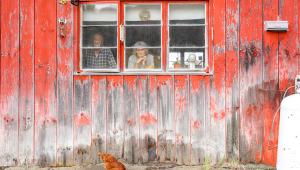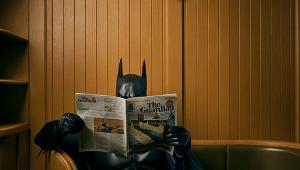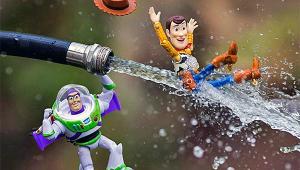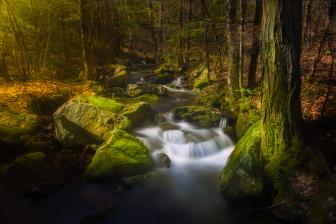The Photography Of Bill Gekas: Inspired By The Old Masters

Inspired by Thomas Lawrence’s famous painting “Pinkie,” photographed at a nearby creek. Technical info: Pentax K-5, with one speedlight firing through an umbrella at camera right; f/4 at 1/125 sec.
All Photos © Bill Gekas
When I first saw this series of images of the little girl, I realized the photographer had carefully posed and lit the images in a delightful manner. The child portrayed in numerous styles is actually quite contemporary and lives with her parents in Melbourne, Australia. Her dad, Bill Gekas, is a professional photographer, self-taught and very adept at portraiture, though his main occupation is managing a family manufacturing business.
When Bill and I got acquainted I found him to be a talented and thoughtful person, and I asked him to share his approach and process on this most wonderful personal project. Accompanying captions on the images go into more detail on each photograph.

Athena dressed in a Victorian-era outfit wearing a cameo brooch. Technical info: Pentax K-5, Westcott Apollo softbox at camera right, grid spot light to background, white reflector at camera left; f/3.5 at 1/125 sec.
Shutterbug: How did you get started with this series?
Bill Gekas: Athena was only 2 1/2 years old when I began the series, and she’s now 6. My initial goal was just personal portraits, but as time passed I realized how many moods and subtle expressions Athena was giving me. So we continued making pictures, which has always been fun and games for her. She has been a revelation for me and my wife, Nikoleta, who plays a major role in the process.
SB: Would you say that because Athena is such a good model that your family enjoys being creative together?
BG: Quite so. I knew that the key to success with Athena was making the photos as much a pleasure for her as possible. This also goes for working with other young children. You should start shooting as soon as the child is on the set, and have your lights and other technicalities in place. In this project, although there are many images in my series, we only shot once every few weeks over several years. We found that limiting the time our daughter posed to about 10 minutes per session was a good pace for all, and we enjoyed an ongoing experience, which we will always remember. The pictures we created are a bonus, though I admit our project has included a bit of insanity that helped flavor our lives.
My photographs have won many international awards, and have been exhibited and published. However, we have had the freedom to be creative together without the pressure associated with commercial work.

Shot on location during a dry summer’s early evening. Technical info: Pentax 645D, D-FA 55mm f/2.8, one bare speedlight fired through a shoot-through umbrella at camera left; f/3.5 at 1/125 sec at ISO 400.

The merchant’s daughter patiently waiting for her father to arrive with surprises from lands afar. Technical info: Pentax K-5, bare speedlight outside window firing in, second bare speedlight pointed to ceiling as bounce for fill light; f/4.5 at 1/90 sec.
SB: What are your wife’s contributions to your project?
BG: Nikoleta found or made all the appropriate costumes for Athena in styles of the past. Sometimes Athena was clothed in bits and pieces of fabric carefully chosen and draped.
SB: In our conversation you used the term “storytelling.” How does that fit into your process?
BG: It’s my interpretation of guiding the viewer to envision the images as telling a story. I try to present viewers with technical and aesthetic images that their imaginations can fill in with story concepts. I’ve found that individuals relate to the images in different ways based on their positive or negative experiences.
SB: How did you continually engage Athena in the process?
BG: She enjoys the creative process itself. The thing is to take advantage of what young children already like, such as dressing in costumes, having their hair done, and acting out in and of itself. We don’t think you can force children to have an emotive connection to the camera. However, it’s fairly regular for us, in the evenings after a shoot, to go to a nice place for dinner and ice cream—which rewards us all.

Preparing pears to sell at the street markets of Delft. Technical info: Pentax K-7, Westcott Apollo softbox at camera left, grid spot light to background, gold reflector at camera right; f/4 at 1/180 sec.

A cosmic child with a thirst for knowledge. Technical info: Pentax K-5, Westcott Apollo softbox at camera left, grid spot light to background, white reflector at camera right; f/4 at 1/180 sec.
SB: How do you create or envision the costumes?
BG: We look for ready-made costumes at reasonable prices first, some of which are fancy dress period clothes online or in upscale dress shops. When that is disappointing my wife sews something together, perhaps from scraps and pieces. We also mix and match from previous shoots to create the illusion of new costumes.
SB: When thinking about photography as a profession, what seems most important to you?
BG: I’ve discovered over the years that good photography depends on problem solving as well as art direction. For me the latter means having a good idea of what costumes I’d like to see Athena wear, and collaborate with my wife. We both look at the styles in old paintings for ideas.
SB: Do your photographic approaches differ at times?
BG: I shoot more traditional portraits if requested, though I prefer to do conceptual work, which I am known for. Ideal sitters are willing to relax and give me creative control, though sadly they are infrequent. A comedian I photographed was a pleasure when we did shots inspired by Dürer self-portraits. The compositional harmony and richness of old master paintings and the relation of tones give their work the overall atmosphere that influenced my work.

A child peeling potatoes during a time of famine.Technical info: Pentax K-5, speedlight fired through a shoot-through umbrella at camera left outside window firing in, white reflector at camera right; f/5.6 at 1/90 sec at ISO 80.

A child working in a laundrette Pre-Industrial Revolution. Technical info: Pentax K-3, Westcott Apollo softbox at camera left, one speedlight firing through window cookaloris for window effect on wall; f/4 at 1/125 sec.
SB: What sort of lighting did you use for this series?
BG: Most often I use Paul C. Buff 640-watt Einstein studio strobes and small RF triggers. I also do portraits outdoors on location with a single speedlight through an umbrella to complement or balance the ambient light. I shoot with either a Pentax 645D (“medium format” digital) or a Pentax K-5 with a Sigma 17-50mm f/2.8 lens.
Photographer Bio
Born and residing in Melbourne Australia, Bill Gekas is a multi-awarded and published fine art portrait photographer. Self-taught and by learning the intricacies of photography since the mid-1990s, he also studied and worked in the IT industry in the early part of his career. After the dot-com bust he decided to involve himself in managing the established family business in the manufacturing sector of the construction industry, which he is stillinvolved with to this day. His admiration and respect for the works of the old master painters has influenced his stylistic approach to the photographic craft. To see more of Gekas’s work, please visit his website, www.billgekas.com.
- Log in or register to post comments

















































